The Russell Wilson era doubled as the peak of the Seahawks’ 46-year existence. The third-round pick Seattle invested in 10 years ago helped the team build a championship nucleus, and after most of the defensive cogs from the back-to-back Super Bowl teams departed, Wilson’s development as a passer kept the Seahawks in the playoff mix. This season will look quite different for the franchise, which bailed on the prospect of an 11th Wilson season and third extension.
Trades:
- Sent QB Russell Wilson to Broncos for 2022, 2023 first-round picks, 2022, 2023 second-round picks, a 2022 fifth-rounder, QB Drew Lock, TE Noah Fant, DT Shelby Harris
- Acquired WR J.J. Arcega-Whiteside from Eagles for DB Ugo Amadi
Hours after Aaron Rodgers‘ Packers recommitment, the Broncos pulled the trigger for Wilson. Pete Carroll‘s Combine comments indicating the Seahawks had “no intention” of trading the top quarterback in franchise history came after GM John Schneider had opened trade talks with Broncos counterpart George Paton. The Wilson-Carroll relationship had steadily deteriorated, and the Seahawks became leery of what it would cost to give their star QB a fourth contract. The noise Wilson made about the team’s offensive line and the trade-destination list that surfaced in February 2021 irked the Seahawks, and the 11th-year veteran was unlikely to do another Seahawks extension. This all led to the HC-GM combo that drafted Wilson dealing him for major draft capital with two years left on his contract.
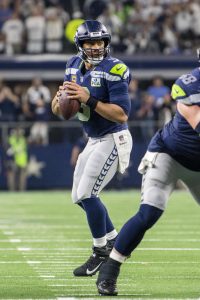 Being willing to part with three first-round picks for Wilson, the Commanders may have presented the best trade package. But Washington was not a Wilson-preferred destination. Although the Bears, Cowboys, Raiders and Saints were on Wilson’s initial 2021 destination list, the Broncos and Giants were quietly added late last year. The Giants and Saints called the Seahawks this year, but Wilson — one of the few NFLers with a no-trade clause — had zeroed in on Denver. For the first time since Matt Hasselbeck‘s 2011 exit ushered in Tarvaris Jackson as Seattle’s starter, the Seahawks have a foggy future at the game’s premier position.
Being willing to part with three first-round picks for Wilson, the Commanders may have presented the best trade package. But Washington was not a Wilson-preferred destination. Although the Bears, Cowboys, Raiders and Saints were on Wilson’s initial 2021 destination list, the Broncos and Giants were quietly added late last year. The Giants and Saints called the Seahawks this year, but Wilson — one of the few NFLers with a no-trade clause — had zeroed in on Denver. For the first time since Matt Hasselbeck‘s 2011 exit ushered in Tarvaris Jackson as Seattle’s starter, the Seahawks have a foggy future at the game’s premier position.
Carroll’s run-heavy M.O. and the Seahawks’ penchant for skimping on offensive linemen (Duane Brown excepted) gnawed at Wilson, the centerpiece of middling rosters over the past few seasons. Seattle attempted more run plays than any team over Wilson’s tenure. Some of those were Wilson scrambles, but Brady Henderson ESPN.com notes team ranked 29th in designed pass-play rate since 2012. That number only climbed to 21st since Wilson broke through as a passer in 2015, making atypical use of a top-tier quarterback contract. Since the “Let Russ Cook” start to the 2020 season preceded a midseason swoon, Carroll largely went back to his preferred style.
Wilson’s extension talks in 2015 and 2019 generated a number of headlines, and each resolution produced a big number ($21.9MM per year in 2015, then-NFL-high $35MM per annum in ’19). Seattle could not recapture the formula it had when it capitalized on one of the great bargains in NFL history; Wilson’s four-year, $2.99MM deal that was on the team’s books as it claimed consecutive NFC championships. During Wilson’s second and third contracts, however, he became one of the NFL’s best quarterbacks.
 Since a 2015 season in which Wilson broke through for 34 touchdown passes (after tossing 20 in 2014), his QBR figures have ranked fourth, 15th, 10th, 11th, fifth, eighth and 10th. The final number came despite Wilson struggling in the games immediately following his finger surgery. Wilson made the Seahawks one of the NFL’s highest-floor teams, though rosters that were not on the level of the 2013 and ’14 squads continually ran into first- or second-round obstacles following Super Bowl XLIX.
Since a 2015 season in which Wilson broke through for 34 touchdown passes (after tossing 20 in 2014), his QBR figures have ranked fourth, 15th, 10th, 11th, fifth, eighth and 10th. The final number came despite Wilson struggling in the games immediately following his finger surgery. Wilson made the Seahawks one of the NFL’s highest-floor teams, though rosters that were not on the level of the 2013 and ’14 squads continually ran into first- or second-round obstacles following Super Bowl XLIX.
Some Seahawks staffers viewed Wilson as declining, at 33, but trading him forfeits the franchise access to the NFL’s most common championship route. Carroll opting for a restart/transition year is a bit curious, considering he is the league’s oldest active HC (71 next week). The strategy will apply considerable pressure for Carroll (signed through 2025) and Schneider to strike gold again. Two first-round picks next year — when a far better QB class is expected to emerge compared to 2022 — will help Seattle’s cause, but the odds are against the Seahawks finding a player capable of Wilson’s performance level. The Seahawks also may see the Texans and Lions, each holding two first-rounders without a clear long-term QB plan as well, outflank them in the 2023 draft.
Schneider sought Lock, having liked the former Missouri prospect in 2019, but the failed Broncos starter not beating out Geno Smith represents an early warning sign of the post-Wilson road the Seahawks are about to travel. Lock and the other below-average brigade of Broncos quarterbacks hindered Fant’s progress, but the former No. 20 overall pick may find footing difficult with Smith and/or Lock (again). Harris, 31, became a steady contributor in Denver, moving into a starter role and helping Vic Fangio‘s defense as an inside rusher and frequent passing-lane deterrent. Harris’ 19 passes defensed during his starter years (2019-21) lead all defensive linemen. Harris’ three-year, $27MM Broncos-authorized extension runs through 2023.
Free agency additions:
- Uchenna Nwosu, DE. Two years, $19.1MM. $10.54MM guaranteed.
- Quinton Jefferson, DL. Two years, $9.5MM. $5.18MM guaranteed.
- Austin Blythe, C. One year, $4MM. $2.5MM guaranteed.
- Artie Burns, CB. One year, $2.04MM. $1MM guaranteed.
- Marquise Goodwin, WR. One year, $1.27MM. $153K guaranteed.
- Justin Coleman, CB. One year, $1.12MM.
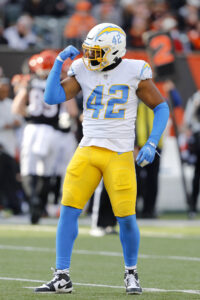 Nwosu will move from Joey Bosa‘s sidekick to a player that will be expected to produce as a No. 1 edge rusher. Swapping out Carlos Dunlap for a younger talent, the Seahawks will bank on Nwosu taking a step forward. Even with Bosa drawing O-lines’ attention, Nwosu registered just five sacks in 17 games. Nwosu’s 30 pressures did rank 31st last season and were six more than any Seahawk logged in 2021. A second-rounder out of USC, Nwosu should be coming into his prime. He will not turn 26 until December.
Nwosu will move from Joey Bosa‘s sidekick to a player that will be expected to produce as a No. 1 edge rusher. Swapping out Carlos Dunlap for a younger talent, the Seahawks will bank on Nwosu taking a step forward. Even with Bosa drawing O-lines’ attention, Nwosu registered just five sacks in 17 games. Nwosu’s 30 pressures did rank 31st last season and were six more than any Seahawk logged in 2021. A second-rounder out of USC, Nwosu should be coming into his prime. He will not turn 26 until December.
A hybrid player who should fit as the Seahawks transition to more 3-4 looks, Jefferson is back after two years away. Seeing time at D-end and D-tackle, Jefferson started 24 games for the Seahawks’ 2018 and ’19 iterations. He made 17 starts for the Raiders last season, totaling career-high numbers in sacks (4.5) and quarterback hits (16).
While Jefferson should be a rotational cog in Seattle, Blythe looks set to go from seldom-used Chiefs backup (12 offensive snaps behind Creed Humphrey last season) to a full-time starter again. This could be an upgrade for the Seahawks. Blythe started at center and guard for three straight seasons with the Rams, including their Super Bowl LIII-qualifying squad. Pro Football Focus graded him as a top-11 guard in 2018 and top-11 center two years later. Blythe, 30, has a clear comeback opportunity for a team that will make no secret of its desire for a smashmouth approach.
Re-signings:
- Quandre Diggs, S. Three years, $39MM. $13.49MM guaranteed.
- Will Dissly, TE. Three years, $24MM. $10.34MM guaranteed.
- Rashaad Penny, RB. One year, $5.75MM. $5.1MM guaranteed.
- Al Woods, DT. Two years, $9MM. $4.73MM guaranteed.
- Geno Smith, QB. One year, $3.5MM. $500K guaranteed.
This season brings 11 starting quarterbacks on rookie salaries, two more on fifth-year options and 19 tied to veteran deals. The veteran contingent now houses nine QBs earning $40MM-plus on average. Four more are tied to contracts worth more than $30MM per year. Tom Brady, who has a few income streams and a lavish FOX contract awaiting him, and Ryan Tannehill come in just south of $30MM AAV. Jameis Winston signed a two-year, $28MM pact, while Marcus Mariota — who has not been a full-time starter since October 2019 — signed a two-year, $18.75MM accord in March. Mitch Trubisky signed a two-year, $14MM Steelers deal. Then, there is Geno Smith, a 10th-year veteran who will be a 2022 starting quarterback on a $1.26MM base salary.
 Smith, 32 next month, will make his first Week 1 start since 2014. Knocked off his Jets QB1 perch in 2015 (the IK Enemkpali incident), Smith not only never regained any footing with the Jets; he kept signing with teams who employed historically durable quarterbacks (Eli Manning, Philip Rivers, Russell Wilson). In what looks like a transition year in which the Seahawks will be connected to college quarterbacks, Smith returns. Discipline for his January DUI arrest may loom, however, though it is not a lock punishment comes this year.
Smith, 32 next month, will make his first Week 1 start since 2014. Knocked off his Jets QB1 perch in 2015 (the IK Enemkpali incident), Smith not only never regained any footing with the Jets; he kept signing with teams who employed historically durable quarterbacks (Eli Manning, Philip Rivers, Russell Wilson). In what looks like a transition year in which the Seahawks will be connected to college quarterbacks, Smith returns. Discipline for his January DUI arrest may loom, however, though it is not a lock punishment comes this year.
Largely unimpressive with the Jets, the veteran backup fared better than expected in his midseason Wilson relief effort (68% completion rate, 5-1 TD-INT ratio, 7.4 yards per attempt). It would seem Lock will work his way into some starts this season, but Smith does profile as the better fit for a conservative offense. For now, Smith will make one of the stranger Week 1 re-emergences in modern QB annals. Although this $3.5MM number is a raise for Smith, the salaries Mariota, Winston and Trubisky are earning illustrate the rest of the league’s view of him. Smith also re-signed in mid-April, after the Browns chose Jacoby Brissett — who is also out-earning Smith — to fill in for Deshaun Watson.
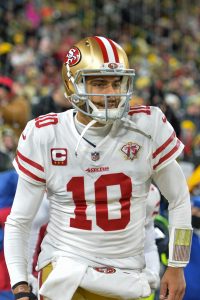 The Seahawks kept passing on the quarterbacks that fell to this year’s third round; they did not view Malik Willis as NFL-ready. Waiting for a superior 2023 class makes sense, and Carroll said post-draft the Seahawks were unlikely to make another QB trade this offseason. They stuck to their guns.
The Seahawks kept passing on the quarterbacks that fell to this year’s third round; they did not view Malik Willis as NFL-ready. Waiting for a superior 2023 class makes sense, and Carroll said post-draft the Seahawks were unlikely to make another QB trade this offseason. They stuck to their guns.
Seattle let Carolina have Baker Mayfield for a conditional 2024 fifth-rounder and showed no interest in parting with an asset for Jimmy Garoppolo. The Seahawks did homework on Garoppolo and lurked as a landing spot for the former Super Bowl starter in free agency, but given how diligent Garoppolo’s camp was in attempting to find a team that would pay more than the money he is now tied to with the 49ers ($6.5MM salary; $15.45MM max value via playing-time incentives), it looks like the Seahawks were not willing to offer too much money. Garoppolo and Mayfield have obviously proven much more than Smith; that could have impeded Seattle’s 2022 plan.
Dealt repeated injury blows, Penny made an 11th-hour push for some second-contract cash and will be Seattle’s Week 1 starter for the first time. As fantasy GMs observed, Penny exploded for four 130-yard rushing games in his final five contests and finished with an NFL-leading 6.3 yards per carry (on 119 totes) in his fourth season. The surprise 2018 first-rounder has missed 28 career games, but the Seahawks offered lower-middle-class running back dough to see how legitimate that season-closing stretch was.
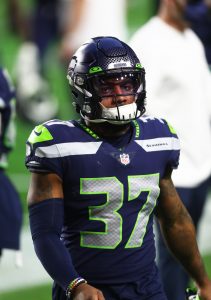 Acquiring Diggs from the Lions in a low-level pick-swap deal has been the better Seahawks safety trade of recent years. The Seahawks, who have not seen their blockbuster Jamal Adams trade and record-setting extension come close to justifying the cost, now have the league’s most expensive safety tandem. Both Adams ($17.5MM per) and Diggs ($13MM AAV) are among the NFL’s 10 highest-paid safeties. With Adams’ hybrid skillset often luring him away from the traditional safety range, more back-line patrolling is required of Diggs. Going into his age-29 season, Diggs has now secured three contracts. He will be a vital piece for a Seattle defense bringing pass-rushing and cornerback uncertainty.
Acquiring Diggs from the Lions in a low-level pick-swap deal has been the better Seahawks safety trade of recent years. The Seahawks, who have not seen their blockbuster Jamal Adams trade and record-setting extension come close to justifying the cost, now have the league’s most expensive safety tandem. Both Adams ($17.5MM per) and Diggs ($13MM AAV) are among the NFL’s 10 highest-paid safeties. With Adams’ hybrid skillset often luring him away from the traditional safety range, more back-line patrolling is required of Diggs. Going into his age-29 season, Diggs has now secured three contracts. He will be a vital piece for a Seattle defense bringing pass-rushing and cornerback uncertainty.
The Broncos nearly kept the Wilson-Dissly pairing alive, pursuing the fifth-year veteran in free agency. Dissly appeared surprised by the market that formed for him. Suffering major injuries in 2018 and ’19, the former fourth-round pick has never topped 300 receiving yards in a season. The Seahawks valued Dissly’s run-blocking skills — more than most envisioned anyone would — and he will team with new receiving tight end Fant. Woods turned 35 shortly after re-signing. The NFL nomad (seven city changes since being a 2010 Saints draftee) has found a home in Seattle, starting 16 games in 2021. PFF graded the 12-year veteran as the No. 4 run-defending D-tackle last season.
Notable losses:
- Marquise Blair, DB (waived)
- Duane Brown, T
- Chris Carson, RB (retired)
- Alex Collins, RB
- Carlos Dunlap, DE (designated as post-June 1 cut)
- Gerald Everett, TE
- Rasheem Green, DE
- Kerry Hyder, DE (released)
- Jamarco Jones, OL
- Benson Mayowa, DE (released)
- Robert Nkemdiche, DL
- Adrian Peterson, RB
- Ethan Pocic, C
- D.J. Reed, CB
- Brandon Shell, T
- Bobby Wagner, LB (released)
 Wagner is closer than Wilson to first-ballot Hall of Fame status, having been a first- or second-team All-Pro eight times. The decorated middle linebacker has more first-team All-Pro nods (six) than any active player save for new teammate Aaron Donald (seven). Wagner, 31, outlasted every Legion of Boom member (by multiple years) on Seattle’s defense and will be the centerpiece defender associated with this Seahawks era. While the LOB may be remembered more for the Super Bowl years, Wagner’s longevity bettered each member. His return from a 2014 injury ignited the Seahawks to a charge that keyed a second straight NFC championship. Last season, Wagner notched a career-best 170 tackles. He will be difficult to replace.
Wagner is closer than Wilson to first-ballot Hall of Fame status, having been a first- or second-team All-Pro eight times. The decorated middle linebacker has more first-team All-Pro nods (six) than any active player save for new teammate Aaron Donald (seven). Wagner, 31, outlasted every Legion of Boom member (by multiple years) on Seattle’s defense and will be the centerpiece defender associated with this Seahawks era. While the LOB may be remembered more for the Super Bowl years, Wagner’s longevity bettered each member. His return from a 2014 injury ignited the Seahawks to a charge that keyed a second straight NFC championship. Last season, Wagner notched a career-best 170 tackles. He will be difficult to replace.
Like Wilson, Wagner signed three Seahawks contracts. Agentless during the third negotiation, Wagner topped C.J. Mosley‘s Jets deal — which came in well north of anything before it at the off-ball linebacker position — with a three-year, $54MM pact in 2019. Wagner did not want to leave Seattle, but the team avoided a $20.35MM cap number via the release — which came hours after the Wilson trade. Jordyn Brooks is now in place as the Seahawks’ top linebacker, but fourth-year backup Cody Barton will make a big responsibility jump this season.
 For the second straight year, a team gave a Seahawks starting corner an eight-figure-AAV deal. The Jets followed the Jaguars (Shaquill Griffin) by handing Reed a three-year, $33MM pact. Reed does not have a lengthy run of starter-caliber play but caught on in that role with the Seahawks in 2020. Seattle found Reed via waivers that year and used him as an outside starter in 22 games from 2020-21.
For the second straight year, a team gave a Seahawks starting corner an eight-figure-AAV deal. The Jets followed the Jaguars (Shaquill Griffin) by handing Reed a three-year, $33MM pact. Reed does not have a lengthy run of starter-caliber play but caught on in that role with the Seahawks in 2020. Seattle found Reed via waivers that year and used him as an outside starter in 22 games from 2020-21.
The Seahawks paid Richard Sherman in 2014, but the Carroll-years formula remains: low- or mid-level draft investments stock this position. The team passed on paying Byron Maxwell in 2015 and let Justin Coleman walk in 2019. Griffin and Reed have now come and gone, leading to more cheap labor via Day 3 draft choices.
Carson’s neck injury continues an unfortunate run for the Seahawks, who also lost Kam Chancellor and Cliff Avril to career-ending neck issues. Seattle’s top post-Marshawn Lynch option, Carson overcame his seventh-round status to tally two 1,000-yard seasons. He was the lead back on three playoff teams. Carson did well to collect a two-year, $10.4MM payday in 2021, joining a host of 2017 running back draftees in signing notable second contracts. He collected $5.5MM guaranteed and will see up to $2MM of his 2022 base salary via the CBA’s injury-protection benefit.
Changing up its defensive scheme, Seattle swapped out nearly its entire edge-rushing crew. Dunlap became a critical part of the team’s mid-2020 defensive turnaround, arriving via trade from Cincinnati. Dunlap notched 13.5 sacks as a Seahawk. Green led the 2021 team in QB pressures with 24, while Hyder and Mayowa did not contribute much to last season’s cause. Dunlap (Chiefs), Green (Texans) and Hyder (49ers) caught on elsewhere.
Draft:
- 1-9: Charles Cross, T (Mississippi State)
- 2-40: Boye Mafe, DE (Minnesota)
- 2-41: Kenneth Walker III, RB (Michigan State)
- 3-72: Abraham Lucas, T (Washington State)
- 4-109: Coby Bryant, CB (Cincinnati)
- 5-153: Tariq Woolen, CB (Texas-San Antonio)
- 5-158: Tyreke Smith, DE (Ohio State)
- 7-229: Bo Melton, WR (Rutgers)
- 7-233: Dareke Young, WR (Lenoir-Rhyne)
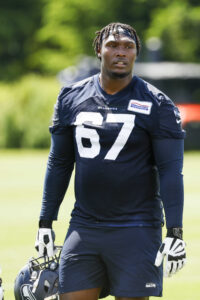 The Seahawks have not had success with a homegrown tackle since their 2010 Russell Okung selection (No. 6 overall). They relied on Duane Brown, obtained via 2017 in-season trade, after Okung’s departure led to blindside instability. Brown kept going into his mid-30s, but his training camp hold-in measure only produced a slight adjustment last year. The Seahawks met with veteran tackle Trent Brown early in free agency, but he re-signed with the Patriots. Instead, Seattle will replace both its tackles with rookies, moving on from Brandon Shell (21 Seattle starts) as well.
The Seahawks have not had success with a homegrown tackle since their 2010 Russell Okung selection (No. 6 overall). They relied on Duane Brown, obtained via 2017 in-season trade, after Okung’s departure led to blindside instability. Brown kept going into his mid-30s, but his training camp hold-in measure only produced a slight adjustment last year. The Seahawks met with veteran tackle Trent Brown early in free agency, but he re-signed with the Patriots. Instead, Seattle will replace both its tackles with rookies, moving on from Brandon Shell (21 Seattle starts) as well.
Cross and Lucas are ticketed to start against the Broncos, marking the first time in decades a team will have gone with two rookie bookends. This could be the start of a long era of Cross and Lucas. April was the first time the Seahawks had chosen even a Day 2 tackle since 2016 (Germain Ifedi); that undoubtedly caught Wilson’s attention from afar.
Seattle used the first Wilson-generated first-rounder on Cross, this year’s third tackle taken. Cross spent most of his time in Mike Leach’s Air Raid offense at Mississippi State, making for an NFL adjustment. That said, Cross earned first-team All-SEC acclaim as a sophomore last season and was PFF’s No. 2 SEC run blocker in 2021. As should be expected from a top-10 pick, Cross offers the kind of upside at the position the Seahawks have not possessed since Okung.
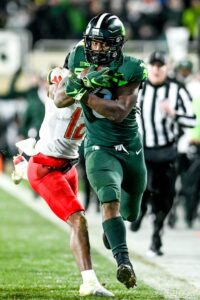 Lucas is a Seattle-area talent whom Leach recruited to play at his previous program. The Washington State product will not need converting to right tackle; he started there for four seasons at the Pac-12 school. These two could use this season to develop ahead of 2023, when the Seahawks will be expected to make their quarterback investment.
Lucas is a Seattle-area talent whom Leach recruited to play at his previous program. The Washington State product will not need converting to right tackle; he started there for four seasons at the Pac-12 school. These two could use this season to develop ahead of 2023, when the Seahawks will be expected to make their quarterback investment.
Walker is battling a hernia issue that is expected to delay his debut. The Wake Forest part-timer turned into a force at Michigan State post-transfer, totaling 1,636 rushing yards and 18 touchdowns. Penny’s one-year deal aside, Walker profiles as the Seahawks’ long-term backfield starter. Mafe notched two sacks in Seattle’s preseason opener, forcing a fumble, and is projected to be a rotational rusher behind Nwosu and Darrell Taylor. The Seahawks missed on L.J. Collier, and Nwosu has not proven much yet. Mafe (seven senior-season sacks) will need to be a regular piece this season.
Woolen looks to have beaten out the non-Sidney Jones veteran wing of the Seahawks’ corner contingent and last year’s Jim Thorpe Award winner (Bryant) to be a Week 1 starter. Woolen’s measurables beat out nearly every corner in NFL history (6-foot-4, 4.26 40-yard dash, 42-inch vertical). ESPN had the converted receiver ranked as a mid-third-round pick. Bryant moved from the outside to the slot during camp. The Seahawks were unable to steadily staff that position in the years since Coleman’s 2019 exit. Back with the team, Coleman could man the job to start the season. But Bryant, who allowed just a 44% completion rate as a fifth-year senior, should see extensive time.
Extensions and restructures:
- Signed WR D.K. Metcalf to three-year, $72MM deal ($31MM guaranteed)
- Gave DT Bryan Mone two-year, $11.04MM contract ($1.5MM guaranteed)
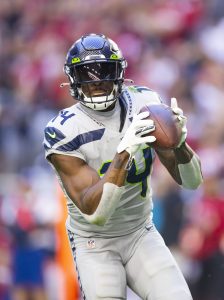 The move away from their franchise quarterback freed up a long-term salary slot, but Schneider expressed amazement at where the wide receiver market had gone this offseason. Months after the Davante Adams and Tyreek Hill deals shook the receiver landscape, the Eagles and Commanders set the market for fourth-year receiver extensions. The Seahawks, after shutting down spring trade inquiries (most notably from the then-receiver-desperate Jets), followed that framework and kept Metcalf.
The move away from their franchise quarterback freed up a long-term salary slot, but Schneider expressed amazement at where the wide receiver market had gone this offseason. Months after the Davante Adams and Tyreek Hill deals shook the receiver landscape, the Eagles and Commanders set the market for fourth-year receiver extensions. The Seahawks, after shutting down spring trade inquiries (most notably from the then-receiver-desperate Jets), followed that framework and kept Metcalf.
Route-tree issues and general rawness dinged Metcalf coming out, dropping him to the No. 64 overall slot. The Seahawks helped Wilson with this find, with Metcalf joining Tyler Lockett to form one of the league’s top receiver pairs. The size-speed freak reached just 967 receiving yards in 17 games last season, but he added 12 touchdowns. College teammate A.J. Brown secured more in per-year salary ($25MM) and guaranteed money ($56MM), though Metcalf’s guarantees will spike to $43MM by May 2023.
Lockett will turn 30 in September and will be remembered as one of Wilson’s wingmen. It is not yet known which quarterback Metcalf will be primarily associated with, and he may have drawn the worst QB situation of all the 2019 receiver extension recipients. But the Seahawks, at least, have receiver certainty. Their low-salary QB picture — a payroll wrinkle that could remain in place through at least 2026, and that is only if a rookie arrives next year — could accompany two big-ticket receiver contracts for a while. Lockett’s $17.25MM-per-year deal — agreed to in April 2021 — runs through 2025.
Other:
- Owner Jody Allen said Seahawks are not for sale
- Picked up $6.9MM fifth-year option on TE Noah Fant; declined $11.5MM 2023 option on DE L.J. Collier
- Promoted Clint Hurtt to defensive coordinator, replacing Ken Norton Jr.
- Promoted Andy Dickerson to offensive line coach, replacing Mike Solari
- Hired Sean Desai as associate head coach; staff target Ed Donatell became Vikings DC
- Front office executive Alonzo Highsmith joins Miami Hurricanes’ staff
- Signed 14 UDFAs
Eight years after the first set of fifth-year options could be exercised, the Seahawks finally saw fit to move a rookie contract to Year 5. Fittingly, for a team that traded out of Round 1 several times or missed on first-rounders during this timeframe, it is another team’s draftee that will see this bump. Fant’s back-to-back 600-plus yard seasons in Denver, which had some notable trouble staffing its QB spot pre-Wilson, were considered underwhelming. The Seahawks have not had a tight end reach 600 yards since Jimmy Graham in 2016.
Donatell was close to joining Seattle’s staff, but the longtime Vic Fangio right-hand man understandably accepted another DC gig in Minnesota. The Seahawks will still import Fangio concepts under Hurtt and Desai, the latter having worked under Fangio during his Chicago stay. Hurtt, 43, was with the Bears during Fangio’s first two Chicago seasons (2015-16) before coming to work for Carroll. With the Seahawks ending their 10-year Wagner partnership and facing questions at D-end and corner, Hurtt inherits a fixer-upper. The Seahawks ranked a surprising eighth in DVOA last season, but Norton’s defense checked in 21st.
Top 10 cap charges for 2022:
- Poona Ford, DT: $10.08MM
- Tyler Lockett, WR: $10.1MM
- Jamal Adams, S: $9.11MM
- Gabe Jackson, G: $9MM
- D.K. Metcalf, WR: $8.84MM
- Uchenna Nwosu, DE: $6.3MM
- Quandre Diggs, S: $5.8MM
- Rashaad Penny, RB: $5.63MM
- Jason Myers, K: $5MM
- Shelby Harris, DT: $4.71MM
The top of Seattle’s payroll reveals how much changed this year. Expectations are unusually low for one of the league’s steadiest franchises, and soon this reset will prompt thorough examinations of the college game’s top arms. Pursuits of the NFC’s seventh seed ended with 9-8 Bears and Eagles teams commandeering those slots over the past two seasons. Given the conference’s depth entering this season, it is not out of the question the Seahawks can hang around.
Of course, before those hopes can be considered realistic, this Seahawks season begins with a NASCAR-style vibe. Their biggest game may well be first on the schedule.

They choose a fossil Coach and mediocre GM over the franchise QB in a power struggle.
I think that the organizational philosophy is that no team can win a championship with a 50 million QB on the roster. Not a bad philosophy, since none ever have.
I like that the owner does not move off their long time coach and exec. Continuity baby, continuity. Very Raven like. By the way, wouldn’t be surprised at all if Lamar is gone after this season … or franchise tagged.
Steelers, Patriots, Ravens, Seahawks…not bad company!
A fossil QB who is in decline, who wanted the moon for his next contract and got it from a foolish denver team who will deeply regret their decisions.
Rebuilding teams should just embrace the suck for two or three years. Trading Metcalf and Lockett would have hurt in the short run but would have set Seattle up for another decade-long run – but they are instead going to subject their fans to countless seasons of missing the playoffs while watching others draft their next franchise quarterback.
What? Why can’t they draft their next franchise QB next year?? I think a lot of “next franchise” QBs come into the league and struggle because they are also on a terrible roster with no Metcalfs or Locketts to help them make the transition to the NFL. The last time the Hawks built a Super Bowl team, the QB was not the first piece, but one of the last.
Solid 2 win team
LOL. I’m kinda curious as to what constitutes a “shaky” 2 win team.
Solid that is fine we can use the #1 pick. Thinking we would have to bundle 2 1st rnd picks to move up a bit. If we get top spot that is not an issue. I am a Seattle fan used to waiting for teams to do well.